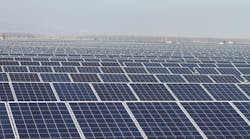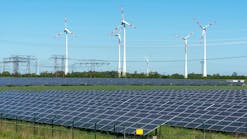U.S. Department Of The Interior Announces Updated Roadmap For Solar Energy Development Across The West
The Department of the Interior has announced an updated roadmap for solar energy development across the West, designed to expand solar energy production in more Western states and make renewable energy siting and permitting on America’s public lands more efficient. The Bureau of Land Management also announced the next steps on several renewable projects in Arizona, California and Nevada, representing more than 1,700 megawatts of potential solar generation and 1,300 megawatts of potential battery storage capacity.
The Department published a draft analysis of the Utility-Scale Solar Energy Programmatic Environmental Impact Statement (known as the updated Western Solar Plan), which would streamline the BLM’s framework for siting solar energy projects in order to support current and future national clean energy goals, long-term energy security, climate resilience, and improved conservation outcomes.
The proposal is an update of BLM’s 2012 Western Solar Plan, which identified areas in Arizona, California, Colorado, Nevada, New Mexico and Utah with high solar potential and low resource conflicts in order to guide responsible solar development and provide certainty to developers. Following months of stakeholder engagements – including 15 public scoping meetings – the updated roadmap refines the analysis in the original six states and expands it to include Idaho, Montana, Oregon, Washington and Wyoming.
In considering updates to the Western Solar Plan, the BLM worked closely with the Department of Energy’s National Renewable Energy Laboratory to examine forecasts for national clean energy needs and determined that approximately 700,000 acres of public lands would be needed to meet those goals. The BLM’s preferred alternative in the updated Western Solar Plan would provide approximately 22 million acres of land open for solar application, giving maximum flexibility to reach the nation’s clean energy goals.
By directing development to areas that have fewer sensitive resources, less conflict with other uses of public lands, and close proximity to transmission lines, the BLM can permit clean energy more efficiently while maintaining robust public and Tribal engagement, which are central features of all BLM reviews of individual projects.
BLM utilized $4.3 million from the Inflation Reduction Act to invest in these important updates to the Western Solar Plan. This investment is helping improve the solar development application process by providing developers with better predictability, while also maintaining sufficient flexibility to address site-specific resource considerations. This planning work also seeks to provide updates that respond to changes, like advances in technology, that have occurred since the BLM’s last programmatic solar development planning effort over a decade ago.
The analysis announced today evaluates six alternatives, each proposing to make different amounts of public land available to solar development applications under different criteria such as proximity to transmission infrastructure, designated critical habitat, or other important ecological and cultural resources. Public input will inform a Final Programmatic Environmental Impact Statement and Record of Decision. The public can submit written comments through April 18, 2024. More details are available on BLM’s Solar Program website.
The BLM also announced next steps on several onshore renewable projects throughout the West, representing significant progress on projects that will help achieve the President’s goal of a 100 percent clean electricity grid by 2035.
In Nevada, the BLM is advancing four proposed solar projects:
The BLM released a draft environmental impact statement for the proposed Libra Solar Project in Mineral and Lyon counties, which, if approved, will generate and store up to 700 megawatts of photovoltaic solar energy that would power approximately 212,233 homes.
The BLM released a draft environmental impact statement for the Rough Hat Clark County Solar Project, which, if approved, will add 400 megawatts of clean solar photovoltaic power to the grid, enough to power approximately 121,276 homes. The proposed project would also include a 700-megawatt battery energy storage system.
The BLM announced a Notice of Intent for the Dodge Flat II Solar project in Nevada, which, if approved, will generate up to 200 megawatts of photovoltaic solar energy on approximately 700 acres of public lands in Washoe county. This would be enough to power approximately 60,638 homes.
The BLM released the draft environmental assessment for the Dry Lake East Energy Center Solar Project, which would build a 200 MW photovoltaic solar facility with 200 MW of battery energy storage and an additional 400 MW battery energy storage facility.
In California, the BLM will release in the coming days a Notice to Proceed for the Camino Solar Project in Kern County, allowing construction to begin on a 44-megawatt photovoltaic solar facility on 233 acres of public land that will power approximately 13,340 homes.
In Arizona, the BLM today announced that construction of the White Wing Ranch Solar Project has been completed. White Wing Ranch is a 179-megawatt solar photovoltaic project located on private lands in Yuma County with a generation interconnection (gen-tie) line across approximately 3.5 miles of BLM administered land. This project has the potential to power 54,271 homes.
The BLM also announced that construction on the Harquahala Valley (HV) Sunrise gen-tie line in Arizona will begin in February. It will connect the HV Sun solar project, which is a 150-megawatt solar photovoltaic project located on 1,000 acres of private lands in Maricopa County, with a gen-tie transmission line across approximately 1.1 miles of BLM administered land. This project will power approximately 45,479 homes.
The BLM is currently processing 67 utility-scale onshore clean energy projects proposed on public lands in the western United States. This includes solar, wind, and geothermal projects, as well as gen-tie lines that are vital to clean energy projects proposed on non-federal land. These projects have the combined potential to add more than 37 gigawatts of renewable energy to the western electric grid. The BLM is also undertaking the preliminary review of over 195 applications for solar and wind development, as well as 97 applications for solar and wind energy site area testing.


